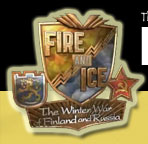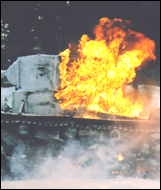

History of the Molotov Cocktail
FINLAND’S SECRET WEAPON:
THE LIQUOR BOTTLE
Until the adoption of diesel
engines in main battle tanks, the humble Molotov cocktail was the “poor man’s anti-tank missile.” For
approximately 70 years it was the great equalizer of urban warfare.
It was cheaply and
quickly made, relatively lightweight and easily concealed. It was the one
plentiful weapon that enabled poorly armed insurgents, or rag-tag partisans,
to stand their ground against an attacker with armored vehicles.
The lowly petrol bomb’s shining moment in history came in October, 1956, when the people of Hungary rose up against the communists. It was the Molotov cocktail that enabled them to briefly seize control of central Budapest. The most powerful image from that rebellion was that of a Freedom Fighter hurling his gasoline bomb at a hulking 32-ton “Stalin” tank. By the time the Hungarian Uprising was crushed by the Red Army, the street-fighters of Budapest had destroyed an estimated 400 Soviet tanks, three-quarters of that number with Molotov cocktails or similar variants of improvised explosive devices.
In the world’s most chronically troubled regions the Molotov cocktail
remains a part of insurgents’ arsenals today. Although its usefulness
against contemporary tanks has greatly diminished, it retains its power as
a symbol of defiance.
There is some debate over the exact date and location of the first battle
in which one side or the other deployed large numbers of petrol bombs.
But historians
generally agree that the first formal deployment of the Molotov cocktail
by an organized army occurred during the Spanish Civil War in September,
1936.
Francisco Franco’s Fascist army was slowly tightening a noose around
Madrid. One of the vital points on its expanding perimeter was the ancient
city of Toledo, some 30 miles southwest of downtown Madrid and near one of
the major highways linking the capitol to the Mediterranean ports where the
Loyalists received the bulk of their foreign arms shipments, including the
first significant shipment of modern tanks and mechanized artillery sent to
them by Josef Stalin.
Both Adolf Hitler and Benito Mussolini were gearing-up to send even bigger shipments to Franco, but conspicuously absent were up-to-date anti-tank weapons. Such cannon were urgently needed as a defense against the large formations of T-26 and T-28 tanks the Loyalists were massing just east and north of Toledo.
Madrid’s defenders planned to take advantage of this temporary superiority
to break the siege by means of the largest, most ambitious offensive operation
undertaken by either side. The eastward approaches to Toledo offered good terrain
for tanks, so that was the sector they planned to hit first and hardest. The
arrival of those Soviet tanks was hardly a secret, and Franco’s soldiers – few
of whom had ever seen an armored vehicle, much less faced one in battle – were
decidedly nervous about the prospect. Not long before the Loyalist artillery
opened-up with its pre-attack barrage, however, Franco’s most exposed
infantry units were bolstered by the arrival of truck-loads of “bottle-bombs,” accompanied
by crudely mimeographed user manuals and cursory instruction by a hastily organized
training cadre.
When the offensive began, the Loyalist tankers – enthusiastic amateurs
that they were – displayed such reckless aggression that their armored
wedges frequently advanced far beyond contact with the infantry assigned to
protect them from close-range assault. The tactical situation was close-to-ideal
for the use of hand-thrown petrol bombs. Once Franco’s soldiers the T-28s
bursting into flames, they quickly regained the initiative and began to go “tank-hunting” with
a vengeance. The effectiveness of the new device was so dramatic that it may
have been the deciding factor in repelling the entire Loyalist counter-attack.
This was the first, and the last, time during Spanish conflict that Molotov
cocktails were used in prolific numbers. Not long after the battle for Toledo,
Franco started deploying his own armored formations, and both sides pitted
tank-against-tank whenever possible.





